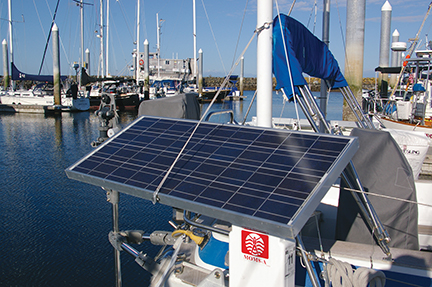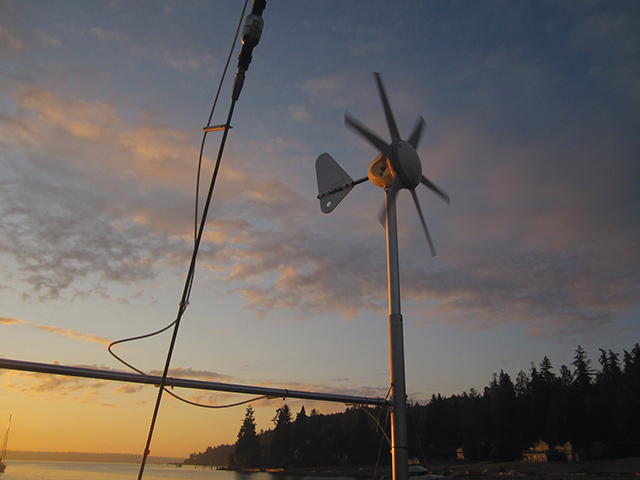Solar, wind and water power for independent cruising (published November 2012)
As I sit and write on a charging laptop, the refrigerator compressor kicks on nearby, music fills the background, and I look up at the stereo, chartplotter, VHF, SSB and modem nestled neatly at the nav station. Underneath my settee is a watermaker and above my head is a light. So what does all this, and more, have in common? It all takes electricity.
It is hard to fathom, but at one point sailing vessels operated without electricity—without engines, even. Some brave souls still cruise this way, but more commonplace is the amenity-driven need for more and more power. Charter companies give clients a requisite number of hours to charge per day, sailing schools preach energy conservation to fledgling cruisers, and boat owners launch into the “this isn’t like your house” speech with every greenhorn who comes to visit.
With our insatiable need for power and an ever-growing list of amenities stacking up, the question is, “How do I create enough electricity to run everything on my boat?” On most boats, the quick and easy answer is to simply start the engine and let the alternator do its job. Sure that’s simple, but it uses fuel and oil, and will have a host of maintenance issues during its lifetime that will need money thrown at them. But the even bigger problem with relying solely on your engine for charging is that it must be run for a long period of time to properly top up your battery bank. This typically means you need to sail with the engine on or run it at anchor. Neither of those are attractive options, as no sailor likes running the engine during a spirited sail or when trying to enjoy a sundowner and conversation while swinging on the hook.
It’s no secret that self-sufficient sailors and landlubbers alike are looking for clean alternatives to power their everyday needs. Wind farms have sprung up all over the country, solar panels are more popular than ever, and using water to create energy has been around for years. And the best part is, once these units have been purchased and installed they are virtually free to operate. So how does this transfer to your sailboat?
When thinking about adding alternative energy to your boat, you need to think first about how much energy you are using during a typical day of cruising. Battery charging is all about replenishing what you’ve used. Start by making a simple chart to figure out how many amp hours you are taking out of your batteries in a 24-hour period. Think about everything you use on board in a typical day of cruising—lights, a refrigerator, electronics, an inverter, etc. From there you can figure out how much power you need to put back into your batteries and what type of alternative energy source (AES) is right for your specific needs.
There are three types of alternative energy sources that work well on the cruising sailboat: solar panels, wind generators and water generators.
SOLAR PANELS
 Solar panels are an obvious choice for many cruisers. Whether cruising in high or low latitudes, harnessing the immense power of the sun is an extremely viable option in keeping your battery bank topped up.
Solar panels are an obvious choice for many cruisers. Whether cruising in high or low latitudes, harnessing the immense power of the sun is an extremely viable option in keeping your battery bank topped up.
The most popular and efficient solar panels on the market are made of crystalline. These are the large panel type that you see on most cruising boats today. The other kind of solar panel you may come across is the film type. These are usually a flexible mat-type panel that works well if you are just trying to keep a small battery topped up, but will not be able to charge the battery bank on a typical cruising sailboat. For charging a large bank of batteries, 75-watt crystalline solar panels are the way to go. When in unobstructed sunlight, a couple of these panels can give you 50 amp hours of charging in a single day. Keep in mind, the more surface area of solar charging you have, the more energy you will be able to create.
Besides cost, a potential problem and prohibitory point that many cruising sailors bring up when thinking about going with solar panels is lack of space. Space is at a premium on a cruising sailboat and figuring out where to mount solar panels can be tricky. Take a look around marinas and anchorages and you will see a host of creative mounting options. An important thing to think about when deciding where to put your solar panels is keeping them out of the shade, as even the smallest amount can have a negative effect on charging.
A common place to mount solar panels is on top of a sturdy bimini or arch. This is a good option as it utilizes space that may not be used otherwise and is a place that will see a substantial amount of sun. A less common space to mount panels is on deck. Most cruising boats don’t have a plethora of deck space, but panels can be mounted on the coach roof in between the mast and dodger if need be. If you choose this option, be aware of the boom and mainsail as they may shade the panels.
These days bat wing-style panel mounting seems to work for a lot of cruisers. In this setup the panels are mounted on the pushpit around the cockpit and are made so they can flip up when sailing or at anchor to get maximum sun exposure. This option works well as the panels are outboard and typically away from shade. Drawbacks can be added windage and the potential for damage when docking, especially against pilings.
WIND GENERATORS
 Wind generators are another great way to produce alternative energy aboard by using exactly what sailors want: wind. The big issue with these units, though, is that they need wind to work. A wind generator will start working at about 5 knots, but will not do a significant amount of charging until you hit the 15-knot range. If your home cruising waters don’t see a consistent amount of wind, then this may not be a cost-effective choice. However, if you are sailing in the trade winds of the Caribbean, a wind generator is a viable option that could generate double the amp hours of solar panels.
Wind generators are another great way to produce alternative energy aboard by using exactly what sailors want: wind. The big issue with these units, though, is that they need wind to work. A wind generator will start working at about 5 knots, but will not do a significant amount of charging until you hit the 15-knot range. If your home cruising waters don’t see a consistent amount of wind, then this may not be a cost-effective choice. However, if you are sailing in the trade winds of the Caribbean, a wind generator is a viable option that could generate double the amp hours of solar panels.
There are various types of wind generators and each comes with merits and detractors. Basically speaking, when thinking about the output of a wind generator, you want to look at blade size. The larger the blades, the more power the unit will produce. The principal downside to larger blade generators is noise—the longer the blades, the louder the unit will be. Smaller units with more blades will be quieter, but may not produce quite as much power. (For a comprehensive comparison of wind generators, see the March 2012 issue of BWS.)
Just like solar panels, you need to find a place to mount a wind generator. The best way to do this is on a pole that allows the wind generator to swivel 360 degrees. This is preferable because you want the unit to work no matter where the wind is coming from. On some ketch-rigged boats, you will see the wind generator mounted halfway up or on top of the mizzenmast and you may still see some halyard-mounted wind generators as well.
WATER GENERATORS
The third alternative energy source, and one that is gaining in popularity, is the water generator. Water generators work like a wind generator does, but by towing a small prop behind the boat. The most basic type of water generator is the trailing-log type. In this setup the generator is mounted on a gimbaled bracket attached to the stern and a length of line is let out with a prop on the end. The faster the boat moves, the more rpms are generated and the more power is produced. This type of water generator would be most effective on a blue water passage, and might not be the type of thing you would deploy on a simple day sail.
Another type of water generator is the outboard-leg model. This unit is mounted on the stern with a generator head on one end and a prop on the other. When underway, the prop end gets lowered into the water and charges with a higher output as the boat moves faster. These work well in all sea conditions and are easier to deploy and recover than a trailing-log unit. Potential problems with these are that the unit has to be mounted to the stern, which takes up space, and they tend to be more expensive.
The future of water generators is in using the boat’s freewheeling prop while sailing to generate power. Several companies are dabbling in these electric motor/generator units and I expect this technology will only expand in the near future.
When sailors dream of leaving the dock, cruising to far-flung islands and living a self-sufficient life, a big part of the allure comes from not being dependent on others for our needs. And one of the biggest requirements we have on modern cruising sailboats is energy. Without it we won’t have electronics to help us navigate, lights to see and be seen, and cold beer to enjoy at the end of a long day. By creating our own energy, we are staying true to the cruising dream of living “off the grid,” which is one of the sweetest delights of sailing.
Andrew Cross is a USCG licensed captain and US Sailing certified sailing and navigation instructor. After putting thousands of miles under his keel on the East Coast and in the Caribbean, he and his wife Jill now reside in Seattle on their Grand Soleil 39, Yahtzee. Catch more of Andrew’s expertise in each week’s edition of www.cruisingcompass.com.

















